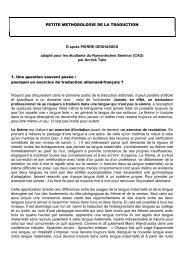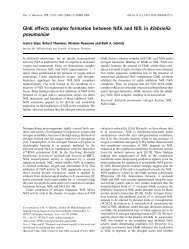Consumer Attitudes towards Regional Food Products - A Case ...
Consumer Attitudes towards Regional Food Products - A Case ...
Consumer Attitudes towards Regional Food Products - A Case ...
You also want an ePaper? Increase the reach of your titles
YUMPU automatically turns print PDFs into web optimized ePapers that Google loves.
1. Introduction<br />
<strong>Consumer</strong> <strong>Attitudes</strong> <strong>towards</strong> <strong>Regional</strong> <strong>Food</strong> <strong>Products</strong><br />
- A <strong>Case</strong>-Study for Northern Germany -<br />
Reimar v. Alvensleben, Suse-K. Schrader<br />
Institute for Agricultural Economics, University of Kiel, Germany<br />
AIR-CAT workshop „<strong>Consumer</strong> <strong>Attitudes</strong> <strong>towards</strong> Typical <strong>Food</strong>s“<br />
22 October 1998 in Dijon, France<br />
Globalization is one of the major trends of our time. <strong>Regional</strong>ization may be understood as a<br />
counter movement against this trend. In many countries we observe an increasing consumer<br />
interest in products of the own region or country. In this case-study we investigate the<br />
consumer attitudes <strong>towards</strong> regional food products in Schleswig-Holstein. We measured the<br />
preferences and tried to estimate the willingness to pay for regional food applying conjoint<br />
analysis and explored the attitudes which are related with the consumer preferences for<br />
regional food. The empirical basis is a consumer survey (random sample, 265 face-to-face<br />
interviews) conducted in summer 1998 in the city of Kiel.<br />
2. Measuring the preferences for regional food by conjoint analysis<br />
2.1. Design<br />
The conjoint analysis has been carried out for two products: butter and fresh potatoes. Each<br />
product has been described by three attributes (price, brand and origin label) at three levels<br />
(chart 1). The three brands got fictitious names, one of them with a regional reference<br />
(Holsteiner Butter, Holsteins Beste). The used origin labels were the official Schleswig-<br />
Holstein quality label and a simple, but large imprint „Aus Schleswig-Holstein“ competing<br />
with products without origin label. The total design consisted of 81 profiles, which have been<br />
reduced to 9 profiles. These stimuli have been offered to the test persons on coloured cards<br />
simulating the total appearance of the products (chart 2). The test persons have been asked to<br />
rank the test products according to their preference. The data set has been analysed with the<br />
software package SPSS 6.1.<br />
2.2. Results<br />
The results of the conjoint analysis are shown in chart 3:<br />
In the case of butter the relative importance of the attributes was 40 % for the price, 24 % for<br />
the brand and 36 % for the origin label. The brand with the regional reference („Holsteiner<br />
Butter“) got a positive part worth, the part worths of the competing brands were negative.<br />
The part worths of the origin labels were positive, too, while the product without an origin<br />
label received a negative part worth.<br />
In the case of potatoes the relative importance of the attributes was 33 % for the price, 27 %<br />
for the brand and 40 % for the origin label. The part worths of the attribute levels showed a
similar pattern as in the case of butter. The origin of potatoes seems to have more importance<br />
for the consumer than the origin of butter.<br />
From these results the following conclusions can be drawn:<br />
1. <strong>Food</strong> products, which are perceived to originate from the own region are prefered to<br />
products with an unknown origin. Brands and labels indicating the regional origin of the<br />
product have a positive part worth. However: The regional origin of a product may be a<br />
decisive criterium in the buying process, only if the differences between the product<br />
alternatives are low. Especially, if the competing products are strong brands, the preferences<br />
for products of the own region are expected to be less pronounced. Unfortunately, we were<br />
not in the position to test this hypothesis within our investigation. Furthermore, it can be<br />
expected, that the conjoint analysis tends to overestimate the influence of the labels, because in<br />
real purchasing situations the stimuli are less recognized than in the test situation.<br />
2. There seem to be no significant differences between the different methods of labeling. There<br />
is no indication, that the official regional quality label is superior to a brand with regional<br />
reference or a simple imprint. The regional quality label is well known in the region, however<br />
its size is rather small and for this reason it may have more difficulties attracting the buyer's<br />
attention to the regional origin of the product than a brand name or an imprint, which can be<br />
integrated into the total product design more easily.<br />
In fact, many consumers claim to have problems recognizing the regional origin of the food<br />
products (chart 4). The responses to an open question revealed that the regional quality label<br />
and imprints are the most frequent marks to identify the regional origin (chart 5). <strong>Food</strong><br />
suppliers intending to make use of the consumer preferences for food of the own region,<br />
should pay particular attention to the problem, how to support the consumer's perception<br />
process. The origin label can influence the buying decision, only if the label is perceived by the<br />
consumer.<br />
3. Willingness to pay<br />
Within the conjoint analysis for each test person the part worths (utilities) of each attribute<br />
level are calculated. Since one of the attributes is the price, the utilities of the other attributes<br />
can be converted into price equivalents. These price equivalents can be interpreted as the<br />
willingness to pay for a certain attribute level in the particular test situation. Example: The<br />
calculated difference between the part worth of the regional brand and another brand can be<br />
converted into a price equivalent indicating the premium the test person is willing to pay for<br />
the regional brand compared to the other brand. Since these price equivalents are differing<br />
between the test persons, demand curves can be constructed showing, how many persons are<br />
willing to pay a certain premium for the brand or label. Chart 6 and 7 are giving examples of<br />
such demand curves: 62 % of the test persons are willing to pay more for the brand<br />
„Holsteiner Butter“ than for butter with the brand „Gute Butter“. 68 % of the test persons are<br />
willing to pay more for butter marked with the imprint „aus Schleswig-Holstein“ than for<br />
unlabeled butter. These curves may have some relevance for pricing food products of regional<br />
origin. In addition they can help estimating the brand equity of a label of origin or a regional<br />
brand.
4. Importance of the regional origin by products<br />
The consumer preferences for the regional origin are differing between products (chart 8). The<br />
test persons have been asked to assess the importance of the regional origin for a selection of<br />
14 food items on a scale from 1 to 5. The highest scores have been given to eggs, meat, milk,<br />
fish, milk products, vegetables, bread/bakeries and sausages, medium scores have been given<br />
to fruit and cheese, while in the case of deep frozen vegetables, noodles, ready dishes and<br />
canned food the regional origin has less importance. Conclusion: The preference for food<br />
products of the own region is especially high for fresh products and much lower for preserved<br />
food. In the case of fresh fruit many test persons may have recognized the fact, that some<br />
fruits cannot be grown in Schleswig-Holstein for climatical reasons. In the case of cheese<br />
many products from other countries, especially from France, have a rather good reputation.<br />
5. Determinants of the preferences for food of the own region<br />
What are the factors determining the preference for food of the own region? On the search for<br />
such determinants we found the following consumer attitudes/beliefs/intentions correlating<br />
positively at least partly with the preferences for regional food, we have estimated in the<br />
conjoint analysis. Each of these attitudes has been measured by two statements, which have<br />
been rated by the test persons on a five-point scale:<br />
1. The willingness to pay for regional products<br />
2. The preference for food from Germany<br />
3. The preference for food of the own region<br />
4. The willingness to support the regional agriculture<br />
5. The preference for regional products because of shorter transportation routes<br />
6. The attachment to the homeland<br />
7. Alienation<br />
8. Concern about food safety<br />
9. Environmental concern<br />
10. Health consciousness<br />
11. Neophobia<br />
A correlation matrix showed that these variables are partly interrelated, however the results of<br />
different factor analyses have not been satisfactory. The causal structure of these variables<br />
remains unclear.<br />
Some additional hints are given by the answers to a projective sentence-completion test (Chart<br />
9). The test persons have been asked to complete the sentence: „I buy products from<br />
Schleswig-Holstein, because....“ The most frequent answers could be classified as follows:<br />
- better product properties (fresher, better quality, better taste, more healthy),<br />
- better production conditions ( more natural, shorter transport routes, more<br />
confidence, not genetically modified), furthermore<br />
- support of the regional agriculture.<br />
It is interesting to note that „patriotic“ arguments have been rare.<br />
Furthermore the preference for regional food can be interpreted as an image transfer between
the region and the product (v.Alvensleben/Gertken, 1993, Schleyerbach/v.Alvensleben, 1998):<br />
Most people living in a certain region are developing emotional relations to their homeland.<br />
These emotions are transferred to the products of this region. In this case the information<br />
about the origin of the product may become a cue or a key attribute in the process of product<br />
perception, especially if other cues or key attributes (e.g. a strong brand) are not available.<br />
The positive emotional attitude <strong>towards</strong> products of the own region may lead to further<br />
positive perception distortions - halo effects - (see also: Han, 1989), which can explain the<br />
rather positive evaluations of regional products in the sentence-completion test.<br />
6. Conclusion<br />
Altogether the determinants of the consumer preferences for food products of the own region<br />
are rather complex. To obtain a deeper insight into the causal relations between the different<br />
variables, it seems to be necessary to develop causal models (example: van Ittersum/Candel,<br />
1998), which was not possible within the scope of this study. We are looking forward to the<br />
presentations and discussions of this workshop, which may give ideas, how to proceed in<br />
further research.<br />
7. Summary<br />
The case-study is based on a consumer survey (n = 265) conducted in summer 1998 in Kiel.<br />
Applying the conjoint analysis the following results have been obtained:<br />
1. <strong>Food</strong> products of the own region are prefered to products with an unknown origin.<br />
2. A majority of the consumers is willing to pay more for a product of the own region than for<br />
products with an unknown origin.<br />
3. The regional preference is higher for fresh products than for preserved food.<br />
4. The preference for regional food can be interpreted as an image transfer between the region<br />
and the product: The regional origin may become a cue or a key attribute in the perception<br />
process which leads to positive perception distortions.<br />
5. A deeper insight into the complex causal structure of the determinants of the consumer<br />
preferences for regional food requires the development of causal models.<br />
References:<br />
v. Alvensleben, R., Gertken, D. (1993): <strong>Regional</strong>e Gütezeichen als Marketinginstrument bei<br />
Nahrungsmitteln. Agrarwirtschaft 42, S. 247-251.<br />
Han, C.M. (1989): Country image: Halo or summary construct? Journal of Marketing<br />
Research, Vol. XXVI, P. 222-229.<br />
van Ittersum, K., Candel, M.J.J.M. (1998): The influence of the image of a geographical area<br />
on the evaluation of food products. AIR-CAT workshop „<strong>Consumer</strong> preferences for products<br />
of the own region/country and consequences for the food marketing“, Kiel 23.-26.4.1998.<br />
Schleyerbach, K., v. Alvensleben, R. (1998): The problem of labeling and branding regional<br />
products. AIR-CAT workshop „<strong>Consumer</strong> preferences for products of the own region/country<br />
and consequences for the food marketing“, Kiel 23.-26.4.1998.
Chart 1: Design of the Conjoint-Analysis<br />
Product Attribute Attribute levels<br />
Butter<br />
Potatoes<br />
1,89 DM/pound<br />
Price 2,19 DM/pound<br />
2,39 DM/pound<br />
“Wiesengrund“<br />
Brand ”Holsteiner Butter“<br />
”Gute Butter“<br />
Schleswig-Holstein-<br />
Quality-Label<br />
Origin label ”Aus Schleswig-Holstein“<br />
without<br />
1,40DM/kg<br />
Price 1,60DM/kg<br />
1,80DM/kg<br />
“Feldknolle“<br />
Brand “Holsteins Beste“<br />
“Bauernlob“<br />
Schleswig-Holstein-<br />
Quality-Label<br />
Origin label ” Aus Schleswig-<br />
Holstein“<br />
without<br />
Source: Institute for Agricultural Economics University Kiel.<br />
<strong>Consumer</strong> survey Kiel 1998 (n = 265).
Chart 2: Conjoint-Stimuli
Butter<br />
Chart 3: Results of the Conjoint-Analysis<br />
Attribute Attribute Level Relative Importance Part Worth<br />
1,89 DM/pound + 1,21<br />
Price 2,19 DM/pound 40 % + 0,01<br />
2,39 DM/pound - 1,22<br />
“Wiesengrund“ - 0,40<br />
Brand “Holsteiner Butter“ 24 % + 0,81<br />
“Gute Butter“ - 0,41<br />
SH-Quality-Label + 0,39<br />
Origin label „Aus SH“ 36 % + 0,52<br />
Potatoe<br />
without - 0,91<br />
Attribute Attribute Level Relative Importance Part Worth<br />
1,40 DM/kg + 0,91<br />
Price 1,60 DM/kg 33 % - 0,01<br />
1,80 DM/kg - 0,90<br />
“Feldknolle“ - 0,28<br />
Brand “Holsteins Beste“ 27 % + 0,64<br />
“Bauernlob“ - 0,36<br />
SH-Quality-Label + 0,69<br />
Origin label „Aus SH“ 40 % + 0,52<br />
without - 1,21<br />
Source: Institute for Agricultural Economics University Kiel.<br />
<strong>Consumer</strong> survey Kiel 1998 (n = 265).
ather yes<br />
a bit of both,<br />
depends<br />
I don´t know<br />
Chart 4: Recognition of the Origin Label<br />
Question: Buying products is it easy for you to see<br />
if the products come from Schleswig-Holstein or<br />
not?<br />
yes<br />
rather no<br />
no<br />
0 5 10 15 20 25 30<br />
%
Chart 5: Question: Think about buying a product from<br />
Schleswig-Holstein. How do you recognize that<br />
the product comes from Schleswig-Holstein?<br />
(open question, multiple answers)<br />
Answer Category Frequency of Answers in %<br />
SH-Quality-Label 49<br />
Origin imprint 45<br />
Typical signs of the region 18<br />
Producer/brand 17<br />
Adress of producers 14<br />
Asking in the supermarket 9<br />
Others 8<br />
Source: Institute for Agricultural Economics University of Kiel. <strong>Consumer</strong><br />
survey Kiel 1998 (n = 265).
Chart: 6<br />
Distribution of the Price Equivalents of the Brand<br />
"Holsteiner Butter" compared with "Gute Butter"<br />
DM per 250g<br />
8<br />
7<br />
6<br />
5<br />
4<br />
3<br />
2<br />
1<br />
0<br />
-1<br />
-2<br />
-3<br />
-4<br />
-5<br />
-6<br />
-7<br />
-8<br />
"Gute Butter"<br />
"Holsteiner Butter"<br />
0% 25% 50% 75% 100%<br />
Persons<br />
Reading: 62 % of the persons are willing to pay more for the brand<br />
"Holsteiner Butter" than for butter with the brand "Gute Butter".
Chart 7:<br />
Distribution of the Price Equivalents of the Imprint<br />
"aus Schleswig-Holstein" Compared with Unlabeled<br />
Butter<br />
DM per 250g<br />
8<br />
7<br />
6<br />
5<br />
4<br />
3<br />
2<br />
1<br />
0<br />
-1<br />
-2<br />
-3<br />
-4<br />
-5<br />
-6<br />
-7<br />
-8<br />
"aus Schleswig-Holstein"<br />
without origin label<br />
0% 25% 50% 75% 100%<br />
Persons<br />
Reading: 68 % of the persons are willing to pay more for butter marked<br />
with the imprint "aus Schleswig-Holstein" than for unlabeled butter.
Question: How important do you regard the Schleswig-Holstein origin in the case of eggs, ...?<br />
Eggs<br />
Meat<br />
Milk<br />
Fish<br />
Milk-products<br />
Vegetables<br />
Bread/ Baker`s ware<br />
Sausages<br />
Fruits<br />
Cheese<br />
Deepfrozen food<br />
Noodles<br />
Ready dishes<br />
Canned food<br />
Chart 8: Importance of the <strong>Regional</strong> Origin by <strong>Products</strong><br />
0 0,5 1 1,5 2 2,5 3 3,5 4 4,5 5<br />
average rank<br />
Scale: 1 = not important at all, 5 = very important<br />
Source: Institute for Agricultural Economics University of Kiel. <strong>Consumer</strong> survey Kiel 1998 (n = 265).
Product<br />
Properties<br />
Chart 9: Sentence-Completion Test<br />
fresher 62 more natural<br />
better<br />
quality<br />
better<br />
taste<br />
more<br />
healthy<br />
production<br />
51 shorter<br />
transportation<br />
routes<br />
37 more<br />
confidence<br />
Production<br />
Conditions<br />
31 not genetically<br />
modified<br />
42 support of<br />
regional<br />
agriculture<br />
Others<br />
25<br />
34 “patriots“ 13<br />
32<br />
13<br />
others 5<br />
Question: On this picture you can see two persons. One of the person says: “I<br />
buy products from the Netherlands because the prices are lower.“ The other<br />
person answers: “I buy products from Schleswig-Holstein, because ...“<br />
How will this person end the sentence? (open question, multiple answers)<br />
Source: Institute for Agricultural Economics University Kiel.<br />
<strong>Consumer</strong> survey Kiel 1998 ( n = 265).








![(Microsoft PowerPoint - Anfechtungsf\344lle[1].ppt [Kompatibilit ...](https://img.yumpu.com/12522243/1/190x135/microsoft-powerpoint-anfechtungsf344lle1ppt-kompatibilit-.jpg?quality=85)







